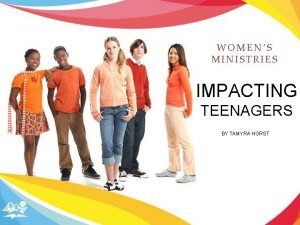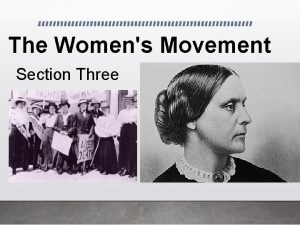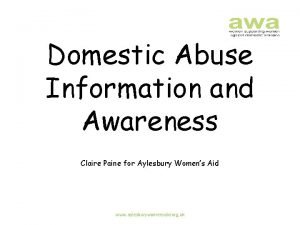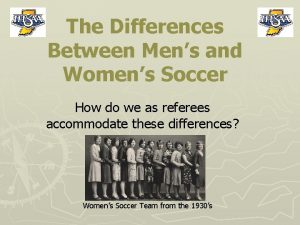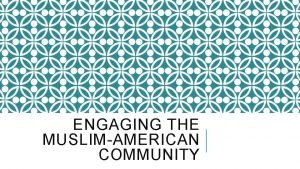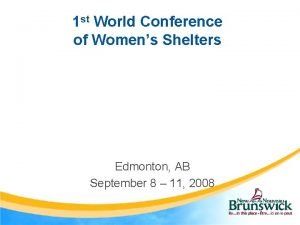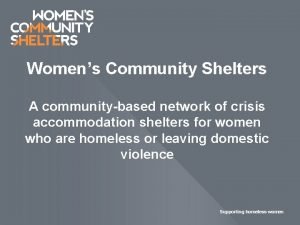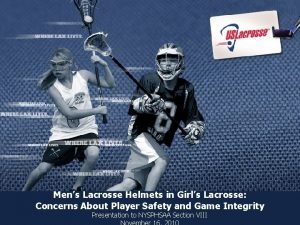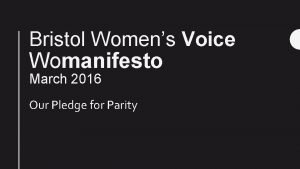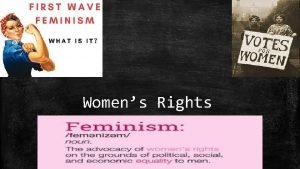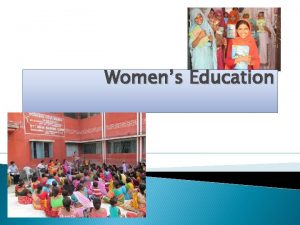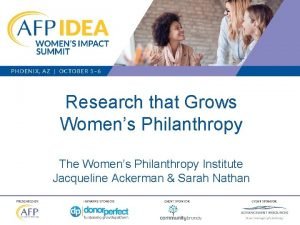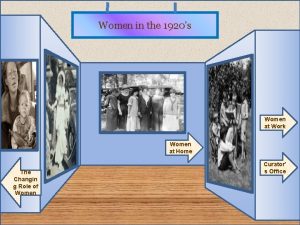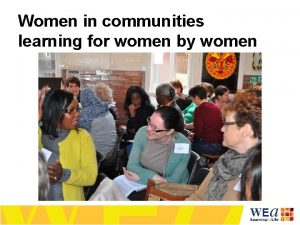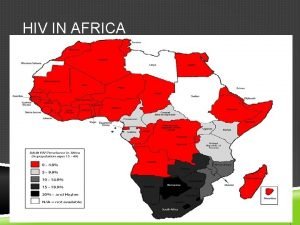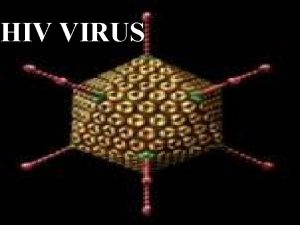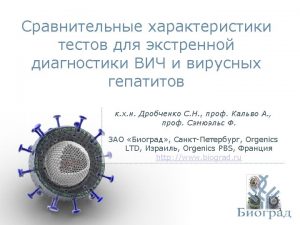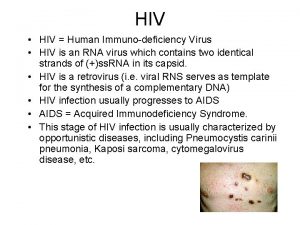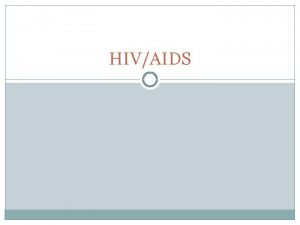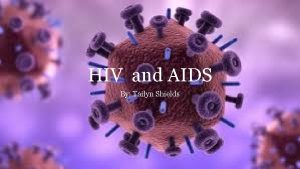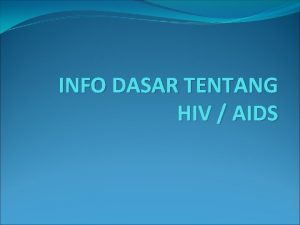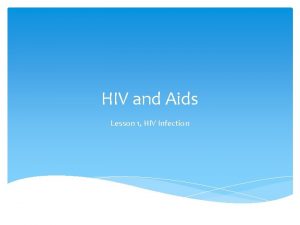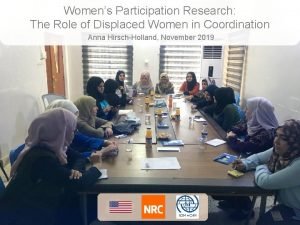Women in HIV CureRelated Research The Womens HIV








































- Slides: 40

Women in HIV Cure-Related Research The Women’s HIV Research Collaborative

The Women’s HIV Research Collaborative

The Women’s HIV Research Collaborative WA PA IN OH CA NC TX MD DC GA The Women’s HIV Research Collaborative

Presentation Overview • Women & HIV • Overview: HIV Cure Research • Women in HIV Cure Research • Recommendations for HIV Cure Research • Opportunities to Get Involved The Women’s HIV Research Collaborative

Women Play Vital a Role in HIV Cure Research The Women’s HIV Research Collaborative

Women & HIV The Women’s HIV Research Collaborative

HIV & Cisgender Women Global Prevalence (UNAIDS/WHO estimates) US (CDC) The Women’s HIV Research Collaborative

US HIV Incidence: Cisgender Women (2017) New HIV Cases for Women in 2017 by Race (CDC) • Cis women made up 19% of new HIV diagnoses in the US overall. • Nearly 60% of diagnoses among cis women occurred in the southern region of the US. • Black/African Americans made up the majority of new HIV cases. • 86% of cis women acquired HIV through heterosexual contact. • 14% acquired HIV through drug use. Other 4. 0% Hispanic/ Latina 16. 2% White Black/ African American 59. 6% 20. 2% These disparities highlight the social and structural issues women face in the US. The Women’s HIV Research Collaborative

Transgender Women & HIV in the US US HIV PREVALENCE 18. 8% HIV PREVALENCE BY RACE/ ETHNICITY: US TRANSGENDER Women Black / African American [CATEG ORY NAME] 44. 2% 0. 5% General Population Transgender Women Hispanic / Latinx [CATEGOR Y NAME] 25. 8% White [CATEG 6. 7% Other ORY NAME] 9. 8% Jeffrey S. Becasen, Christa L. Denard, Mary M. Mullins, Darrel H. Higa, Theresa Ann Sipe, “Estimating the Prevalence of HIV and Sexual Behaviors Among the US Transgender Population: A Systematic Review and Meta-Analysis, 2006– 2017”, American Journal of Public Health 109, no. 1 (January 1, 2019): pp. E 1 -e 8. DOI: 10. 2105/AJPH. 2018. 304727. The Women’s HIV Research Collaborative

Transgender Women & Viral Suppression Among Ryan White Clients (2016) NHAS 2016 Target for Trans Women (74. 7%) [VALUE] Transgender Women Overall Source: Centers for Disease Control and Prevention. Monitoring selected national HIV prevention and care objectives by using HIV surveillance data—United States and 6 dependent areas, 2015. HIV Surveillance Supplemental Report 2017; 22(No. 2). The Women’s HIV Research Collaborative

Overview: HIV Cure Research The Women’s HIV Research Collaborative

What does “HIV cure” mean to you? Source: https: //www. positivelyaware. com/articles/what-does-hiv-cure-mean-you The Women’s HIV Research Collaborative

Cure: A Loaded Word The NIH makes an important distinction: • Classic cure: eliminating all cells with HIV from the body • Sustained ART-free remission: HIV remains present, but at undetectable levels without ART • In the context of clinical trials, “cure” may be defined by different endpoints or clinical measures (size of reservoirs, extent of immune response, etc). In other words, “cure” doesn’t always mean the same thing to everyone! disease CURE disease disease diseas e The concept of “cure” has multiple social/cultural connotations. disease diseas e Cure: “the strategies that eliminate HIV from a person’s body, or permanently control the virus and render it unable to cause disease” (AVAC). disease The Women’s HIV Research Collaborative

Main HIV Cure-Related Strategies Source: http: //treatmentactiongroup. org/cure/trials The Women’s HIV Research Collaborative

A Broad Spectrum of Strategies • Treatment Action Group (TAG), with support from the Bill and Melinda Gates Foundation, conducted a landscape analysis of current HIV cure trials. • There are presently 128 HIV cure-related trials grouped into 24 different categories, reflecting the breadth of strategies under consideration. • Combined, the 128 studies plan to enroll a total of over 7, 000 participants. • Individual studies’ recruitment targets are between 5 and 905 participants. • Most of these studies are early development trials (Phase I or Phase II). Source: https: //www. treatmentactiongroup. org/cure/tri The Women’s HIV Research Collaborative

A Major Investment by Participants Many of the studies in TAG’s analysis require multiple study visits and at least one invasive procedure. Currently, most cure studies offer no direct benefit to participants (e. g. they are not expected to actually cure participants of HIV). • At least 32 require an analytic treatment interruption (ATI). • Sites and study teams will need to think carefully about how to engage communities that have been historically underrepresented in research. • At least 67 require invasive procedures like rectal biopsies, lengthy imaging procedures, lymph node biopsies, lumbar puncture, leukapheresis, and/or stem cell transplants. *Information on study procedures was collected from the clinicaltrials. gov listings. It is possible that there additional invasive procedures that were not submitted to the registry record. The Women’s HIV Research Collaborative

Women in HIV Cure Research The Women’s HIV Research Collaborative

NIH Revitalization Act of 1993 • NIH policy: women and minority groups must be included in all NIH-funded clinical research, unless a clear and compelling rationale establishes that inclusion is inappropriate. • The inclusion of women must be addressed in research proposals, including the composition of the study population in terms of sex/gender and racial/ethnic group. • Sex differences are strongly encouraged in results for all publications. • Women of childbearing potential should not be routinely excluded. • The NIH Director. . . • shall ensure that the trial is carried out in a manner sufficient to provide for valid analysis of whether the variables being studied affect women differently than other subjects. • shall conduct or support outreach programs for the recruitment of women and minority groups. • Applicable to Phase III and pivotal Phase II and IV studies. Source: https: //grants. nih. gov/grants/funding/women_min/guidelines. htm The Women’s HIV Research Collaborative

Sex Matters The Women’s HIV Research Collaborative

Hormones & HIV Cure Research Estrogen is a key mediator of the immune system. “Estradiol at peak menstrual cycle levels is a potent inhibitor of viral reactivation suggesting important differences between [cis] men and women for viral replication and reservoir sizes. ” “The design of regimens for proviral reactivation needs to account for estrogen, and perhaps other hormones, as confounding factors affecting potency” (Karn, 2015). Nearly a decade after demonstrating oral Pr. EP’s safety and efficacy overall, we are just now beginning to understand the role of hormones in Pr. EP effectiveness for cisgender and transgender women. We should start with hormones and other sex differences in mind as we explore HIV cure strategies for all women. Source: Karn, J. (2015) Estrogen blocks HIV re-emergence from latency and points to gender-specific differences in HIV reservoirs. Project Inform webinar, September 4, 2015. The Women’s HIV Research Collaborative

So, are women included? Image credit: Liz Barr The Women’s HIV Research Collaborative

ifi ns nt e t i en . . 25 ly tr. es in 75 ar n/ e tio ca cc va tic io n at 100 ap eu nt 100 Th er 0 tm ea Percent Female 0 14 27 86 pl a rs hi bi to in e ns ra ll t ce em na l io at rv rs 73 St so m ea ot Pr Ob se 77 ito s to r 23 nh ib Ri TO m [VALUE] [VALUE] bi s [VALUE] [VALUE] in hi nt ie io ns ap th er e Ge n kp oi ec ch un e m Im at bi n Co m ro tic ib An tif s od ie An tib e tiv ra ife y or at m m ol pr ti- fla in Percent Male Tr Image credit: Liz Barr An An ti- Participants’ sex from TAG’s Analysis 4 27 96 73 The Women’s HIV Research Collaborative

So, what about transgender women? There is only one transgender woman documented as having participated in an HIV cure study. HIV cure research must become trans-inclusive in all aspects, including study design, data collection, recruitment and retention, analysis, reporting, and staffing. The Women’s HIV Research Collaborative

The MOXIE Trial (ACTG A 5366) ta. MOXifen to Increase the Effects of vorinostat First HIV cure-related study designed specifically for cisgender women with HIV. • Testing two drugs to see if they can reactivate the “latent” HIV that can’t be detected by the immune system • 30 participants: 20 women with tamoxifen plus vorinostat, 10 women with vorinostat alone • All 30 women stay on their regular HIV treatment throughout the study • Includes a socio-behavioral sciences component at study entry and exit Lessons learned about recruitment: • It is possible to recruit women in HIV cure-related research! • Women greatly appreciated having a study dedicated to them. BUT we shouldn’t have to create an HIV cure study specific to women! • Sex/gender-based analyses should be built into all studies • Need to set minimum enrollment for women • Studies with female-relevant strategies should have a plan for inclusion of women The Women’s HIV Research Collaborative

Why are women being excluded? Common themes: “Women are the same as men, so we don’t need them in trials. ” “Women are different from men, so we need to exclude them from trials. ” Are women the same or different? Cis and trans women have a right to benefit from HIV cure research. Adapted from Rowena Johnston (amf. AR) The Women’s HIV Research Collaborative

Barriers for Women Recruitment strategies that don’t emphasize diversity Trial safety concerns Disclosure to family & coworkers Trans women miscategorized and excluded Distrust of research Transportation Strict scheduling windows Stigma Lack of appropriate incentives Invasive Procedures Concerns about hormonal interactions Time investment Rigorous eligibility reqs Lack of cultural humility for transgender women Caretaker / family / work obligations Intimidated / anxious with medical professionals Source: Sullivan PS et al. J Natl Med Assoc. 2007; 99(3); 24250. Gianella S et al. Journal of the International AIDS Society 2016, 19: 20706 The Women’s HIV Research Collaborative

Facilitators to Women’s Participation • Flexible schedules • Open early/stay open late • Provide transportation assistance • Bus pass, parking fees, cab vouchers, Uber/Lyft • Better (closer, safer) parking • Resources for children and family on site • Coloring books, DVD players • Wi-Fi • Food, snacks, drinks • Appreciation and recognition of women’s efforts to participate Adapted from Kate Starr on behalf of the WHRC The Women’s HIV Research Collaborative

Facilitators to Women’s Participation Compared to men, cis and trans women are more likely to be motivated by: • Feeling good helping others like themselves • Receiving money for transportation • Getting special knowledge about their own health • Having someone to speak to about their HIV status • Engaging with research teams • Being treated as a special patient • Having regular access to study nurses • Receiving support from family and friends • Being compensated • Being offered a meal Adapted from Dubé, K and Evans, D. 2018 NIH-sponsored Workshop on HIV Cure. The Women’s HIV Research Collaborative

Recommendations for HIV Cure Research The Women’s HIV Research Collaborative

Transgender Training Curriculum for HIV Research At the very least… • Use the 2 -step method for data collection • Gender identity • Sex assigned at birth • Always describe study populations accurately in protocols, publications, and other study documents • Cisgender and transgender • Assigned Male/Female/Intersex at birth https: //daidslearningportal. niaid. nih. gov The Women’s HIV Research Collaborative

Research Recommendations (continued) • • • Reprioritize the vision of the NIH Revitalization Act Design studies with strategies relevant to cis and trans women Build sex- and gender-based analyses into protocols and statistical analysis plans Require minimum enrollment for cis and trans women Report results by sex and gender (even with 0 women enrolled) Include social scientists to address issues related to women’s enrollment and retention Pay attention to what women need and want Engage women and community members at all stages of HIV cure research Actually enroll and retain women Source: Regulation of Clinical Research Related to HIV Cure meeting in Bethesda, MD (January 2018). The Women’s HIV Research Collaborative

Get Involved! The Women’s HIV Research Collaborative

Join the WHRC! Contact Brian Minalga: Recent Topics: bminalga@fredhutch. org • Women and HIV cure research www. facebook. com/HANCLegacy. Project • HIV prevention research for cis and trans women • Pregnancy and lactation in HIV clinical trials • Mental health, HIV, and gender • Screening for intimate partner violence in HIV research • Women of color in research • Building partnerships with other women-centered organizations The Women’s HIV Research Collaborative

WHRC’s Webinars See the WHRC’s three-part webinar series on women & HIV cure research: https: //www. hanc. info/cp/resources/Pages/Legacy-Project-Webinars. aspx The Women’s HIV Research Collaborative

ACTG & IMPAACT ACTG: AIDS Clinical Trials Group https: //actgnetwork. org/ IMPAACT: International, Maternal, Pediatric, Adolescent AIDS Clinical Trials Network https: //impaactnetwork. org/index. htm Consider engaging with: • Community Advisory Boards • Community Scientific Subcommittee (CSS) • Women’s HIV Inter-network Scientific Committee (WHISC) The Women’s HIV Research Collaborative

Martin Delaney Collaboratory Programs & CABs (2016 -2021) The Women’s HIV Research Collaborative

International Workshop on HIV & Women Recent Topics: • HIV cure research: considerations for women • Current controversies for ART use in women of childbearing potential and in pregnancy • ART in women overall • New drug delivery systems: are they right for women? https: //www. virology-education. com/event/upcoming/9 th-hiv-women-workshop/ The Women’s HIV Research Collaborative

Participate In A Trial! https: //www. youtube. com/watch? v=jmaa. Mv 1 Pal A The Women’s HIV Research Collaborative

Get Informed amf. AR (Foundation for AIDS Research) Consortium on HIV Eradication: https: //www. amfar. org/cure/ Institute for HIV Cure Research: https: //www. amfar. org/Cure-Research-Institute/ Treatment Action Group - http: //www. treatmentactiongroup. org/cure POZ. com - https: //www. poz. com/tag/cure The. Body. com - https: //www. thebody. com/category/curing-hiv International AIDS Society - https: //iasociety. org/hivcure Positively Aware - https: //www. positivelyaware. com/ The Women’s HIV Research Collaborative

Acknowledgments The Women’s HIV Research Collaborative is grateful to the Division of AIDS at the National Institute of Allergy and Infectious Diseases, part of the National Institutes of Health, for making HIV cure-related research possible by funding the vital work of its HIV research networks. A special thanks to the following individuals who developed this training: Liz Barr, ACTG Community Scientific Subcommittee Karine Dubé, University of North Carolina-Chapel Hill Leah Franklin, University of Maryland Brian Minalga, Office of HIV/AIDS Network Coordination Julie Patterson, CWRU/UHC AIDS Clinical Trials Unit CAB, AIDS Funding Collaborative Kacie Sadorra, Office of HIV/AIDS Network Coordination The Women’s HIV Research Collaborative
 Womens ministry activities
Womens ministry activities Womens rights
Womens rights Late night womens hour
Late night womens hour Claire paine
Claire paine Womens right
Womens right Difference between mens and womens soccer
Difference between mens and womens soccer Womens college kumbakonam
Womens college kumbakonam Womens college kumbakonam
Womens college kumbakonam Womens right
Womens right Womens shelter edmonton
Womens shelter edmonton Women's rights
Women's rights Womans anatomy
Womans anatomy Womens history month door
Womens history month door Womens community shelters
Womens community shelters Ballybeen womens centre
Ballybeen womens centre Scarborough womens centre
Scarborough womens centre Mens lacrosse helmet
Mens lacrosse helmet Bristol womens voice
Bristol womens voice Hát kết hợp bộ gõ cơ thể
Hát kết hợp bộ gõ cơ thể Bổ thể
Bổ thể Tỉ lệ cơ thể trẻ em
Tỉ lệ cơ thể trẻ em Voi kéo gỗ như thế nào
Voi kéo gỗ như thế nào Thang điểm glasgow
Thang điểm glasgow Chúa sống lại
Chúa sống lại Kể tên các môn thể thao
Kể tên các môn thể thao Thế nào là hệ số cao nhất
Thế nào là hệ số cao nhất Các châu lục và đại dương trên thế giới
Các châu lục và đại dương trên thế giới Công thức tiính động năng
Công thức tiính động năng Trời xanh đây là của chúng ta thể thơ
Trời xanh đây là của chúng ta thể thơ Mật thư tọa độ 5x5
Mật thư tọa độ 5x5 Làm thế nào để 102-1=99
Làm thế nào để 102-1=99 Phản ứng thế ankan
Phản ứng thế ankan Các châu lục và đại dương trên thế giới
Các châu lục và đại dương trên thế giới Thơ thất ngôn tứ tuyệt đường luật
Thơ thất ngôn tứ tuyệt đường luật Quá trình desamine hóa có thể tạo ra
Quá trình desamine hóa có thể tạo ra Một số thể thơ truyền thống
Một số thể thơ truyền thống Cái miệng nó xinh thế chỉ nói điều hay thôi
Cái miệng nó xinh thế chỉ nói điều hay thôi Vẽ hình chiếu vuông góc của vật thể sau
Vẽ hình chiếu vuông góc của vật thể sau Thế nào là sự mỏi cơ
Thế nào là sự mỏi cơ đặc điểm cơ thể của người tối cổ
đặc điểm cơ thể của người tối cổ
